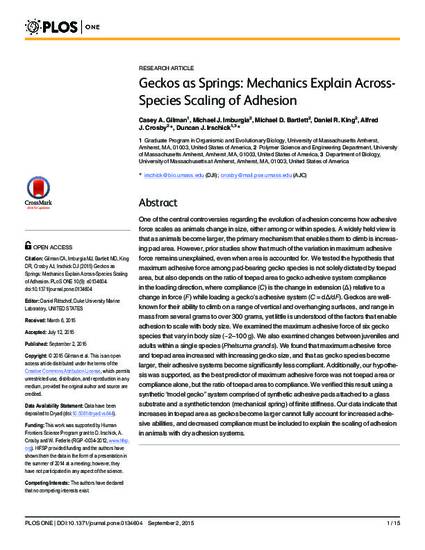
Article
Geckos as Springs: Mechanics Explain Across- Species Scaling of Adhesion
PLoS ONE
(2015)
Abstract
One of the central controversies regarding the evolution of adhesion concerns how adhesive
force scales as animals change in size, either among or within species. A widely held view is
that as animals become larger, the primary mechanism that enables them to climb is increasing
pad area. However, prior studies show thatmuch of the variation inmaximum adhesive
force remains unexplained, even when area is accounted for.We tested the hypothesis that
maximum adhesive force among pad-bearing gecko species is not solely dictated by toepad
area, but also depends on the ratio of toepad area to gecko adhesive system compliance
in the loading direction, where compliance (C) is the change in extension (Δ) relative to a
change in force (F) while loading a gecko’s adhesive system (C = dΔ/dF). Geckos are wellknown
for their ability to climb on a range of vertical and overhanging surfaces, and range in
mass from several grams to over 300 grams, yet little is understood of the factors that enable
adhesion to scale with body size.We examined themaximum adhesive force of six gecko
species that vary in body size (~2–100 g).We also examined changes between juveniles and
adults within a single species (Phelsuma grandis). We found thatmaximum adhesive force
and toepad area increased with increasing gecko size, and that as gecko species become
larger, their adhesive systems become significantly less compliant. Additionally, our hypothesis
was supported, as the best predictor of maximum adhesive force was not toepad area or
compliance alone, but the ratio of toepad area to compliance. We verified this result using a
synthetic “model gecko” system comprised of synthetic adhesive pads attached to a glass
substrate and a synthetic tendon (mechanical spring) of finite stiffness. Our data indicate that
increases in toepad area as geckos become larger cannot fully account for increased adhesive
abilities, and decreased compliance must be included to explain the scaling of adhesion
in animals with dry adhesion systems.
Disciplines
Publication Date
September 2, 2015
DOI
10.1371/journal.pone.0134604
Publisher Statement
Copyright: © 2015 Gilman et al. This is an open access article distributed under the terms of the Creative Commons Attribution License, which permits unrestricted use, distribution, and reproduction in any medium, provided the original author and source are credited.
Citation Information
Casey A. Gilman, Michael J. Imburgia, Michael D. Bartlett, Daniel R. King, et al.. "Geckos as Springs: Mechanics Explain Across- Species Scaling of Adhesion" PLoS ONE Vol. 10 Iss. 9 (2015) Available at: http://works.bepress.com/michael-bartlett/2/
